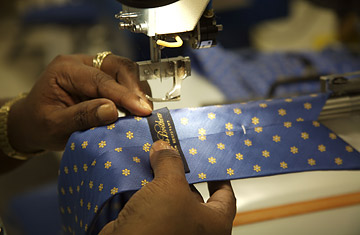
After a 16-step assembly process, the ties wind up at their last inspection before being wrapped, boxed and shipped to stores around the world.
Domingo Ramirez is a cutter on the tie-factory floor. He unrolls silk fabric from a long bolt and smooths it out on the cutting table. Then he lays down a cardboard pattern, draws a chalk outline and cuts the material with a circular knife. Like cutters around the world, Ramirez does this a hundred times a day. But unlike almost all of them, he does it in the U.S.--in New York City, specifically, just a 15-minute car ride from the Madison Avenue headquarters of his employer, Brooks Brothers.
Most apparel manufacturers went overseas in search of cheaper labor years ago--90% of the clothes Americans buy come from places like China, Mexico, Bangladesh, Honduras, Indonesia and Vietnam. Nearly a million people in the U.S. worked in apparel manufacturing in 1990; today fewer than 200,000 do, according to the Bureau of Labor Statistics, an obliteration of the field in less than 20 years. Yet within this classic example of globalization, Brooks Brothers has a message: Sometimes it makes sense to stay at home.
It's counterintuitive to say the least. Back in 2001, when Claudio Del Vecchio, the son of an Italian eyeglasses magnate, was thinking about buying Brooks Brothers from the British retailer Marks & Spencer, the sales pitch included a familiar refrain: a new owner could close the Queens, N.Y., tie factory, move manufacturing overseas and save a ton of money. DelVecchio did buy the company, but he didn't close the factory. Instead, he plowed millions of dollars into improving it. Now every single Brooks tie, whether sold in Detroit, Milan or Dubai, starts there. "Of course we could go to China and make a tie much less expensively," says Joe Dixon, Brooks' senior vice president of production and technical services. "But that's missing the whole point."
The point is that there are real advantages to having your factory in your backyard--from being able to test new fabrics and make changes quickly to fostering collaboration with suppliers on innovations like stain resistance to having a handy place to iron and repackage ties on their way to outlet stores. "We do a lot on the fly, which would be hard to do offshore," says Laura Rowen, director of manufacturing.
At the top of the list of advantages is the way Brooks manages its inventory. The company can put a new tie on the shelf, see how it sells and, if it's a runaway, make and ship more within days. At the factory, a tie starts at one end with a cutter like Ramirez and then works its way in a bundle of 50 down the football-field-size room. All 16 steps--including sewing the tie's blade to its tail, adding a lining, pressing the tip and turning the tie right side out--take about an hour. "The flexibility to reproduce something if it's doing well or to not produce a lot of something if we don't know it's going to do well has a benefit on top of the bare cost of producing that one tie," says Del Vecchio. "We can get things in three days if we want to. China could never do that."
To be fair to the legions of apparel manufacturers who have gone overseas, the economics of making a Brooks Brothers tie in the U.S. are far different from those of making, say, plain cotton underwear. About 70% of the cost of making a Brooks tie comes from materials (the company imports almost all its silk fabric from England and Italy), which leaves a fairly small fraction of the cost coming from labor. Compare that with making a Brooks shirt, for which the proportion is flipped--just 30% of the cost of production is from the material--and it's easy to see why chasing the least expensive workers isn't nearly as imperative in tie manufacturing as it might be elsewhere. There's also the convenient fact that customers are willing to pay a premium to shop at Brooks: its ties retail from $75 to $165. "If the customer doesn't care about the price, then the retailer shouldn't care about the cost," says Mike Todaro, managing director of the American Apparel Producers' Network.
Brooks, though, isn't oblivious to the price it pays for goods. The company's other U.S. factory, a shirt plant in North Carolina, provides a good comparison. Brooks sells more than 3.5 million shirts a year but makes only about 250,000 at its factory, which is reserved for higher-end wares such as made to order and the Golden Fleece brand. Most of the others come from Malaysia. "Part of it is the prestige of having shirts handcrafted in our own factory," says Dixon. "It's a marketing initiative." The tie factory, though, offers no such appeal. Even most apparel insiders don't know that all 1.7 million Brooks ties produced annually are made in New York.
In other words, Brooks has found enough genuine operating reasons to stay in the U.S. And it all works out, says Del Vecchio, because of the company's commitment to constantly upgrading its technology, like the automated cutting machine installed in March 2007. (Ramirez and other cutters still handle the most expensive and delicate fabrics by hand.) "If you don't believe in a factory, you don't buy new machinery, and other people beat you at quality and productivity," says Del Vecchio. "It's the dog eating its own tail, and in the end, you have to close. That's the story of a lot of American manufacturing." At the Brooks tie factory, they tell a different one.
